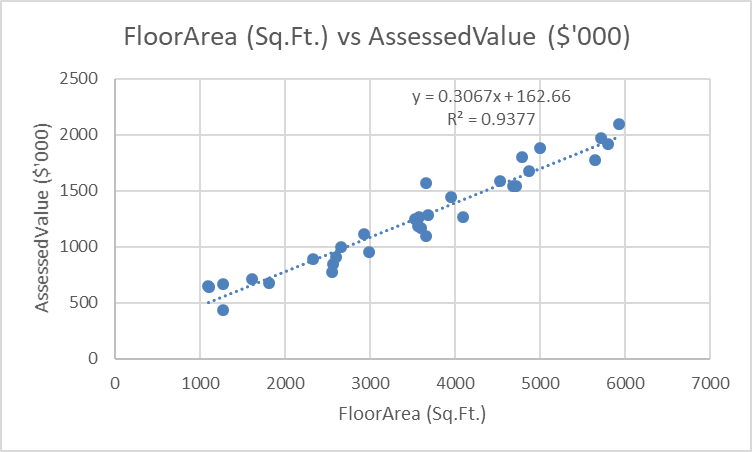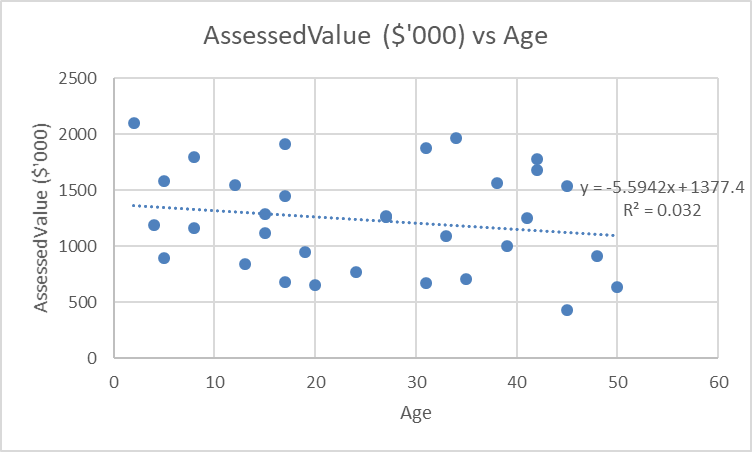
From figure 1 above, the tax assessment value and the FloorArea have an increasingly positive relationship. There is a linear relationship between the two variables, which is portrayed by the closeness of the plotted points in the above scatter plot. Furthermore, the R-Square value is 0.9377, which implies that 93.77% of the variation in the tax assessment value can be explained by the floor area. The large R-square value indicates that the model is significant and useful in predicting the tax assessment value, hence a substantially linear relationship between the two variables.
Table 1: Regression analysis of FloorArea and AssessmentValue
From table 1 above, FloorArea is a significant predictor of the tax assessment value. This is because the R-square value is0.9377. Taking into consideration the sample size of the data, the adjusted R-square value is 0.93356. This implies that 93.356% of the tax assessment value can be explained by FloorArea based on the sample (David, 2018). The variation between R-square and adjusted R-square shows that the model is significant; hence FloorArea is a useful predictor.

There is a negative decreasing relationship between tax assessment value and age. This is portrayed by the scattering of the plotted points together with the trend line. The value of R-square is very small, implying that the model is insignificant.
Table 2: Regression analysis of tax assessment value and age
From table 2 above, age is not a significant predictor of tax assessment value. This is because the R-squares value of this regression model is 0.032, implying that 3.2 % of the variation of tax assessment value can be explained by age (David, 2018). Furthermore, the adjusted R-square taking into consideration the size of the sample, shows that -0.00022, which is 0.022% of the variation in tax assessment value, can be explained by age based on the sample size. There is a significant variation between the R-square value and the adjusted R-square; hence Age is not a suitable predictor in this model.
Table 3: Multiple regression model involving AssessmentValue, FloorArea, Offices, Entrances, and Age
Table 3 above shows that the variables are significant in predicting the tax assessment value based on the R-square value and the adjusted R-square value. The R-square value is 0.953037, implying that 95.30% of the variation in the tax assessment value is determined by the combined variation of FloorArea, offices, entrances, and age. The adjusted R-square is 0.946079; considering the sample size, 94.61 of the variation in tax assessment value is determined by the combined variation of FloorArea, offices, entrances, and age. Using α = 0.05, the significant variables are floor area and offices. This is because they are the only variables with p-values less than 0.05 (Lisi, 2019). Entrances and age are insignificant because their p-values are greater than 0.05 hence not suitable for predicting the tax assessment value.
Table 4: Multiple regression model involving floor area and offices
From table 4 above, the multiple regression model involving FloorArea and Offices is AssesedValue = 0.2641 x FloorArea + 78.3391 x Offices + 115.9136. Using the model AssessedValue = 115.9 + 0.26 x FloorArea + 78.34 x Offices, the tax assessed value is 1182.58. Using the database model, the value is 1,051.70. The value is consistent with minor variation in tax assessment value.
References
David, M. (2018). Simple Linear Regression.A Guide to Business Statistics, 133-147. Web.
Lisi, G. (2019). Sales comparison approach, multiple regression analysis and the implicit prices of housing.Journal of Property Research, 36(3), 272-290. Web.